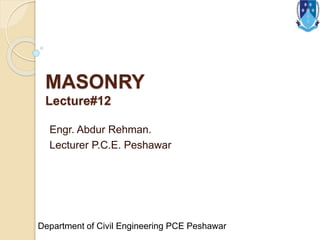Masonry
- 1. MASONRY Lecture#12 Engr. Abdur Rehman. Lecturer P.C.E. Peshawar Department of Civil Engineering PCE Peshawar
- 2. Masonry ï Masonry means construction of buildings using building blocks like stone, bricks, concrete blocks etc. ï Masonry is used for the construction of foundation, walls and columns. ï Mortar is the binding material for the building blocks.
- 3. BRICK MASONRY ï Brick masonry is built with bricks bonded together with mortar. ï For temporary purposes mud mortar may be used but for all permanent buildings cement mortars are used.
- 4. Technical Terms Brick : Masonry unit in the form of a rectangular block made of clay. 19 x 9 x 9 cm size. Brick Tile : Thickness comparatively less than that of a brick. 19 x 9 x 3 cm size. Frog : Depression provided in the face of a brick .
- 5. Header course Stretchers course Queen closer ISOMETRIC VIEW
- 6. ContâĶ Queen Closer : The portion of a standard brick made by cutting it across the length into two equal parts is called Queen Closer.
- 7. ContâĶ King Closer : The portion of a standard brick made by cutting off the triangular piece between the center of one header and one stretcher face.
- 8. ContâĶ Bevelled Closer : The portion of a standard brick made by cutting off the triangular piece between the center of one header face and the opposite corner of the stretcher face.
- 9. ContâĶ Mitered Closer : The portion of a standard brick having its one end cut through or mitered for the full width.
- 10. ContâĶ Half Bat Portion of brick cut half across the width.
- 11. Bonding in Brickwork The process of arranging bricks in different courses in order to tie them together in unified mass of brickwork is called bonding in brickwork.
- 12. Types of Bonds The various types of bonds generally used in brick masonry are I. Stretcher bond II. Header bond III. English bond IV. Flemish bond etc
- 13. Stretcher Bond ï A stretcher is the longer face of the brick as seen in the elevation. ï In the brick of size 190 mm à 90 mm à 90 mm, 190 mm à 90 mm face is the stretcher. ï In stretcher bond masonry all the bricks are arranged in stretcher courses
- 14. Cont.. ï However care should be taken to break vertical joints. ï This type of construction is useful for the construction of half brick thick partition wall.
- 15. Cont..
- 16. Header Bond ï A header is the shorter face of the brick as seen in the elevation. ï In a standard brick it is 90 mm à 90 mm face. ï In header bond brick masonry all the bricks are arranged in the header courses
- 17. Cont.. ï This type of bond is useful for the construction of one brick thick walls.
- 18. English Bond ï In this alternate courses consist of headers and stretchers. ï This is considered to be the strongest bond. ï Hence it is commonly used bond for the walls of all thicknesses.
- 19. Cont.. ï To break continuity of vertical joints a brick is cut lengthwise into two halves and used in the beginning and end of a wall after first header. This is called queen closer.
- 20. Flemish Bond ï In this type of bond each course comprises of alternate header and stretcher. ï Alternate courses start with stretcher and header. ï To break the vertical joints queen closers are required, if a course starts with header.
- 21. Cont..
- 22. Points to be Observed in Supervising Brick Masonry ConstructionsThe following points should be observed in the construction of brick masonry: ï Use bricks of good quality with uniform colour, well burnt, with exact shape and size. ï Before using the bricks in masonry, they should be soaked in water for 2 hours so that bricks do not absorb water from the mortar. ï Bricks should be laid with the frog pointing upward. ï Construction of brick wall should start from the end or corner. ï Brick courses should be perfectly horizontal.
- 23. ContâĶ ï Mortar used should be as per specification. ï Brick masonry should be regularly cured for 2 weeks. ï For carrying out brick work at higher levels, only single scaffolding should be used.























